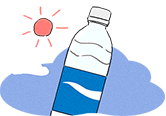Case studies revealing how to prevent heat disorders
Case studies highlighting situations in which extra attention should be paid and action taken to prevent heat disorders, such as during sports activities and in the workplace.
Heat disorders occur frequently in sports in people aged 10 to 19. Looking at heat-related fatalities that have occurred in school sports, the number of fatalities occurring in baseball players stands out. Among non-school sports, many fatalities are seen in mountain climbing.
In 2010, when Japan saw a record-breaking heat wave, the number of fatalities resulting from heat disorders increased significantly.
Heat disorders occur not only during exercise or when working under direct sunlight. The number of incidents involving heat disorders occurring indoors has also increased in recent years.
Heat disorders in sports
Case study
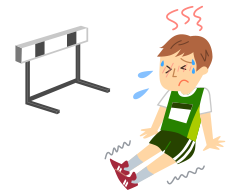
Case A was a boy, a junior in the high school baseball team. During vacation just after exam week, he traveled with the baseball team to a training camp. On the first day of camp, the team practiced in scorching temperatures that reached 35℃. Practice ended in the morning, and the team jogged 5km back to the dorm while drinking water. After arriving at the dorm, the boy's conversation was abnormal, and he was carried to his room to rest, but he started having trouble breathing, and was taken to hospital by ambulance.
The "Exercise Guidelines for Preventing Heat Disorders" specifies that, on days when the temperature exceeds 35℃, or on days when the humidity is high, even if the temperature is not that high, exercise should, as a rule, be suspended. When exercising in the heat, heat disorders can occur if regular rest breaks are not taken and adequate rehydration is not practiced. Case A practiced baseball and jogged in the scorching heat right after exam week, meaning that his body had not become acclimated to the heat.
Heat Disorders by Activity (1975 to 2011)
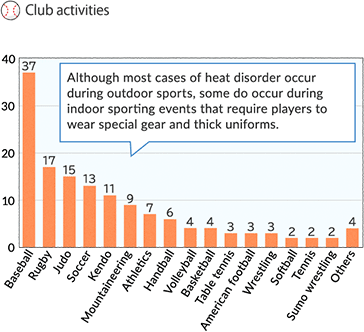
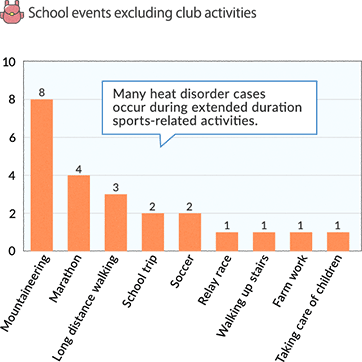
Source:
Ministry of Education, Culture, Sports, Science and Technology, Japan
Sport Council. "Heat Disorders - Knowledge and Prevention"
Heat disorders in the workplace
Case study
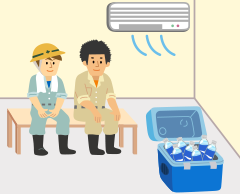
Case B was a 37-year-old male who worked for a construction company. He checked his own health using a health control sheet during a morning meeting. He was working to erect scaffolding in a place without a breeze on a hot, humid day. The rest area had an awning, and was supplied with ice, sports drinks, pickled plums, etc., but offered no means of cooling one's body. At around 10 a.m., he felt numbness and cramp in his right leg, and drank 2 cups of water. He rested for 15 minutes and recovered, and then returned to work. He started feeling ill at lunchtime, and became unable to walk, and was immediately taken to hospital in an ambulance.
This is an example of measures taken to ensure the safety of workers being inadequate. Although drinks were provided, Case B did not get enough breaks while working long hours. Additionally, the rest area was hot and had no breeze, thus not allowing the body to cool sufficiently.
During physically intensive work, salt (sodium) is lost from the body through sweat and must be replaced together with fluid. However, case B only drank water. Education on the prevention of heat disorders at work is recommended to prevent these incidents reoccurring.
Looking at past heat disorders fatalities by occupation, the construction industry accounted for more than 40% of all of the fatalities across all industries, followed by the manufacturing industry at about 20%. The most common time of occurrence was in the afternoon on hot and humid days in July and August. Also, nearly 40% of these cases occurred within seven days of people starting work.
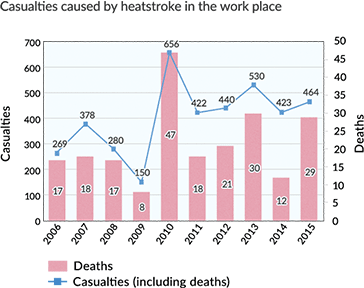
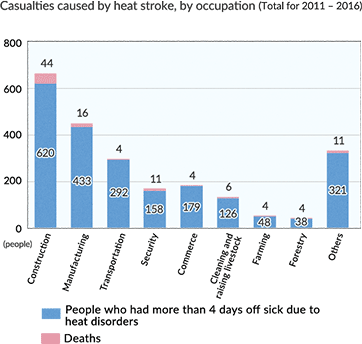
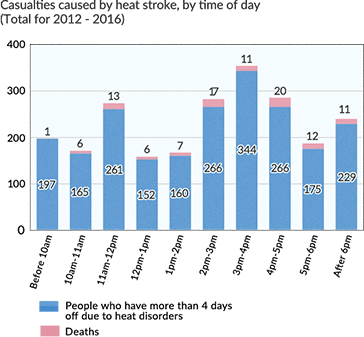
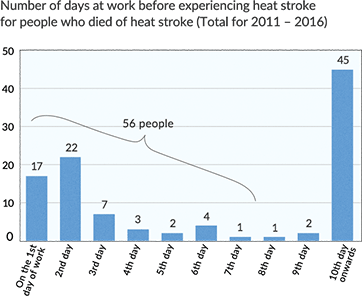
Source: Ministry of Health, Labour and Welfare. Heat-Related Fatalities in the Workplace (2015)
Heat disorders indoors
Case study
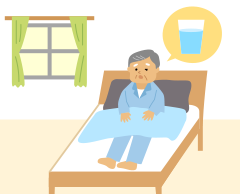
Case C (a 70-year-old male) had recently caught a cold and was feeling weak, and was therefore not taking his regular walks. He didn't have much appetite, either. It was his habit to drink tea to stay hydrated, and he would have one beer at suppertime. When he went to his bedroom on the second floor, he found that it was hot and stuffy, but because he was trying to save energy, he didn't turn on the air-conditioner. Before going to bed, he became thirsty, but he was worried it would make him go to the bathroom, so he just drank a little water and then lay down. During the night, he woke up because he felt nauseous, and his family called an ambulance to take him to hospital. He received intravenous fluids, recovered from his dehydrated state, and was discharged after a short hospital stay.
Case C had many of the characteristics that can result in heat disorders. He was weak and did not have much strength, and because he had not been eating, he was getting very little water through his food. Both the tea and the beer had a diuretic effect, so he was not staying hydrated. Even though it was hot, he put up with it, and did not turn on the air conditioner. Also, because he was worried about having to go to the bathroom he didn't drink enough water. All of these were triggers for the heat disorder he developed.






